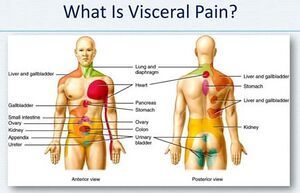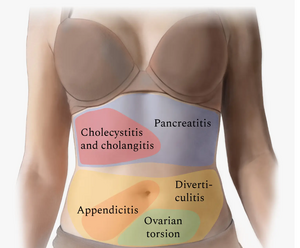Abdominal Pain
Characteristics of abdominal pain[edit | edit source]
Abdominal pain is one of OMG possitive signs. If it is presented, the pacient is in need of immidiate medical care
Abdominal pain is of two types:
- Somatic pain – sharp pain (stinging), precisely localized and accompanied by local palpable soreness;
- Visceral pain - dull pain, without exact localization (located mainly in the midline);
- pain originating from:
- from the esophagus, it is projected behind the upper, middle or lower part of the sternum, depending on the place of origin of the disease process,
- from the stomach it projects into the epigastrium,
- from the small intestine it projects to the area around the navel,
- from the large intestine, it projects from the navel to the lower abdomen.
- pain originating from:
- What do we ask about?
- intensity of the pain (it is important to evaluate the intensity of the pain with indirect signs such as position)
- duration of the health problems
- localisation
- if there is a triggering factor (diet, position, time of the day, stress)
- accompanying symptomes (fever, vomiting, diarrhoea, constipation, character od the stools, dysuria)
- time context is also important (mostly in psychogenic pain)
Origin of abdominal pain[edit | edit source]
Pain in the abdominal area can have different origins. Any abdominal pain should be investigated, we must exlude acute abdominal syndrom.
- Pain in the upper abdomen radiating to the neck, limbs or back can be one of the symptoms of gastroesophageal reflux.
- Deep, dull pain above the navel radiating to the back occurs with acute inflammation of the pancreas.
- Dull pain in the back and side can accompany renal colic.
- Pain in the right subcostal region is typical for inflammation of the gallbladder.
- A dull, sharp pain in the right subclavian often indicates liver problems. Pain in the right lower abdomen may signal appendicitis.
- During pregnancy, a woman experiences mild abdominal pain (they can be caused by stretching of the uterine ligaments) or a hardening of the abdomen.
- During menstruation and ovulation, women have cramps in the lower abdomen.
Types of pain[edit | edit source]
Colic is a strong, wave-like, mostly cramping pain that has its peaks and troughs over the course of minutes. The pain is caused by convulsive contractions of the smooth muscle of the hollow organ, which, with its peristalsis, tries to release an obstacle in the lumen (e.g. a stone in the bile duct). Colic is usually accompanied by nausea and sweating. Biliary colic occurs in connection with the intake of fatty foods, its onset is typical late or at night. Renal colic occurs suddenly, usually as a result of exertion or shock, most often in patients with kidney stones.
Rhythmic pain follows the rhythm of food in its origin and course. Early rhythmic pain occurs about an hour after eating food, an example is pain in stomach ulcer disease. Late rhythmic pain occurs more than 2 hours after eating and disappears after the next meal, an example is a duodenal ulcer.
According to periodicity, we divide abdominal pain into:
- paroxysmal pain – difficulties appear several times during the year at irregular intervals, lasting several days;
- impact pain – difficulties last a few times a year for a longer period of time;
- seasonal pain – difficulties regularly follow the seasons;
- wave-like pain - the difficulties never completely disappear, their intensity changes over the course of the year
Infantile colic[edit | edit source]
- ill-defined problems in early infancy, affecting about 1 in 10 infants both breastfed and formula-fed babies suffer from them these problems usually disappear by 3 months of age
- clinical picture: episodes of marked irritability and abdominal pain with leg elevation they are tied to food, they appear in the second half of feeding, they stop after eating
- worse in the afternoon and evening they are accompanied by borborygmas ("tummy growling") and flatulence
- examination: exclusion of other causes (hunger, thirst, urinary tract infection, otitis)
- sometimes the cause is cow's milk or lactose intolerance
- therapy: in breastfed children, it sometimes helps to remove milk from the mother's diet (we then have to supplement her with calcium) hospital care – only in case of protracted or severe problems, failure to thrive and very anxious parents
- diff. dg: in very strong pains, it may be intussusception (intussusception) - classic triad: 1. colicky pains, 2. intussusception tumor in the abdomen, 3. stools in the form of blood-stained mucus (only in about 20%)
Syndroms of abdominal pain[edit | edit source]
Purely visceral syndrome – dull pain that is not precisely localized, is accompanied by vomiting and diarrhea, the pain is usually rhythmic and means a more superficial irritation of the organ, typical of an uncomplicated ulcer;
Visceral syndrome with referred pain - more persistent pain radiating in a certain direction, means greater anatomical involvement (for example, an ulcer penetrates deeply);
Somatic syndrome – sharp pain that is localized, the disease process affected the innervated tissue, an example is a sharp perforation of the stomach wall or acute cholecystitis.
When examining abdominal pain, it is good to note:
- relation to food intake – we assess whether the patient feels abdominal pain before, during or after eating;
- stomach ulcers cause pain immediately after eating;
- duodenal ulcers cause pain with a delay;
- gallbladder colic often occurs at night after a few hours;
- in pancreatitis, they were first immediately after a meal (in an advanced stage, it is no longer tied to food)
- the type of food that caused the pain
- pain after ingestion of fats and proteins occurs in pancreatic disease;
- pain after a fatty meal is often caused by a gallbladder attack;
- sweets and white pastries cause heartburn
- a position that brings relief to the patient
- with gastroduodenal ulcers, the patient feels relief lying down;
- with gallbladder colic, the patient crouches down and presses his fist into the painful area;
- in reflux esophagitis, the patient is relieved by an upright position;
- pain onset – where the pain started and where it propagates;
- in general, pains in the epigastrium are of gastric origin;
- with ileus, the patient describes dull, wave-like pains that spread throughout the abdomen;
- pain spreading to the right lower abdomen often signals acute appendicitis.
Sources[edit | edit source]
Following articles[edit | edit source]
Sources[edit | edit source]
- CHROBÁK, Ladislav, et al. Propedeutika vnitřního lékařství. 2. vydání. Grada, 2003. ISBN 80-247-0609-1.



